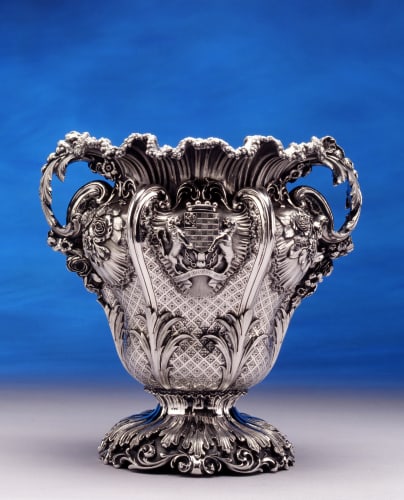BENJAMIN SMITH (1764 - AFTER 1826), ENGLISH
Benjamin Smith was highly gifted silversmith, whose career was intimately connected with the leading silver craftsmen and manufacturing firms at the turn of the Eighteenth Century He was born in Birmingham and recognised as an "ingenius chaser" when in 1790 he was introduced to Matthew Boulton (1728-1809). Boulton had a highly successful factory outside Birmingham, producing plate by improved mechanical mean; in conjunction hr produced buttons, buckles and belts. By 1792 Boulton had Benjamin Smith (in association with Smith's Brother, James). By 1792 Boulton had Benjamin Smith (in association with Smith's brother James) had set up a subsidiary firm to manufacture latchets (shoe fastenings), in 1794 Benjamin and James were described as button manufactueres. However by 1802 Benjamin had moved to Greenwich, London where he set up a silver workshop. In October1802 he entered into partnership with his friend and silversmith, Digby Scott. Smith's move to London was probably supported by the Crown Jewellers and Silversmith, Tundell and Bridge, who, having initially subcontracted work, wanted to establish their own workshops, the first at Lime
Kiln Lane, Greenwich which was managed by Benjamin Smith and the second by Paul Storr ( 1771 - 1844) in Dean Street.
Silver pieces by Storr and Smith for Rundell's is often indistinguishable, one esample being the Trafalgar Vase presented to surviving senior officers at the Battle of Trafalgar. Its neo-classical form and decoralion was designed by John Flaxman (1755-1826). At least 66 vases were produced by Kundell s made either by Storr or Smith and associates, one such vase bears Benjamin Smith and Digby Scott s marks, 1805-6 (Victoria and Albert Museum. London). Smith, like Storr worked from drawings by William Thced (previously a modeller at Wedgwood) who designed a neo-classical wine cooler based on an Antique vase in Villa Albani (after a drawing by C.H.Tatham, 1799). This was reproduced frequently, with variations to the base, by both Smith, and Storr. At other times Storr and Smith worked in conjunction, a silver-gilt tea pot and hot water jug on stand made for Rundell s by Storr, 1804-5 has spirit burners by Smith and Scott (Victoria and Albert Museum). In 1807 Digby Scott parted from Smith, two years later the latter was in partnership with his brother, James (dissolved by 1812). Most notable of this period are a set of eight silver-gilt sugar vases in the Grecian style (Royal Collection, Windsor), one made by Benjamin, 1808 and the others by Benjamin and James. 1809 These are very close to a set of four made by Storr for Lord Harewood in 1814.
Benjamin Smith parted from Rundell's in 1814. by 1816 he was in partnership with his elder son, Benjam Jnr. but by 1818 was again independent. His reputation as a master silversmith secured some important commissions, including pieces for the Wellington presentation plate, notably a huge pair of candelabra, 1816 and the Wellington Shield with myriad figures in relief. 1822, both designed by Thomas Stothard; in addition Smith made the Wellington Vase. 1824-5 (all at Apsley House, London). However Smith was probably at his best working on a smaller scale, excelling in the production of silver salvers, trays. Grecian sugar bowls or elegant tea sets. This is evident in one of his most important productions - the Jamaica Service of 1803 (Royal Collection. Windsor), with its distinctive and accomplished open-work vine borders to the silver-gilt trays, baskets and wine coasters.
Copyright by Richard ReddingLtd.
